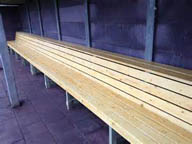As the San Francisco Giants begin Spring Training their front office management is tinkering with a radically new approach to the construction of this season’s 25 man roster.

I know what you’re thinking (probably out loud in that downstairs room with the Galen Erso posters and Bipolar Sunshine stuffed in your inner ear).
“Sure, cannabis was recently made legal in California but I never thought it would lead to such reckless talk.”
But hear me out while I talk some recent history (as we so often do here).
For a long time after 2003 the San Francisco Giants seemed to have no idea what kind of ball player should be on their big league bench backing up the starters. Then, from 2012 to 2016, the front office settled on what they thought was a winning formula.
Sign one of each of the following for the bench:
1. A low cost infielder who can’t hit;
2. A marginal outfielder who can catch the ball, but can’t hit; and,
3. An unknown player plucked from the “dumped-by-other-teams” list. Then convince the fanbase that the front office just found a gem in the recycling bin, and all the other 29 other teams missed out on him!
So from category #1 we had infielder Joaquin Arias from 2012-2016 (795 ABs, .632 OPS); infielder Ehire Adrianza from 2013-2016 (291 ABs, .605 OPS); and 1B Brett Pill from 2011-2013 (240 ABs, .643 OPS).
There were also a number of other no-hit infielders sitting on the bench during this time period.
In category #2 we had outfielder Gregor Blanco 2012-2016 (2,516 ABs, .694 OPS).
In a recent piece by Bill James he listed the top 25 worst RBI producers per RBI opportunity in baseball from 2009-2016. Blanco came in at #17, knocking in only 172 RBIs in 500 RBI opportunities (and getting “D-” grade from Mr. James).
The third category is the most painful.
There were a series of untalented players signed by the Giants the past ten years not for what they could bring to their teams, but simply because they didn’t cost too much.
In 2014 it was second baseman Brandon Hicks.
Hicks used up 204 ABs to put up a .599 OPS and a .166 BA while striking out 77 times. Giants radio announcers toed the party line and told the fans that Hicks was a potential gold glove infielder. He was quietly designated for assignment on July 11, 2014.
In 2015 it was outfielder Justin Maxwell.
Beginning in Spring Training the Giants front office tried to get the fans worked up about Maxwell. Just how did all those other teams overlook this talented player?
Given 249 ABs that season Maxwell responded with a .209 BA, a .616 OPS, and 76 strikeouts. He was cut loose on September 1, 2015.
In terms of salary, Hicks and Maxwell barely cost the Giants anything. Which was exactly the point.
However, those 452 at-bats of almost exclusively sub-par performance cost the Giants at least league-average run scoring from their bench for two seasons.
[Understand that “league average” isn’t bad—it’s actually really outstanding. We’re talking about the average performance within an entire group of amazingly talented athletes.]But let’s move on to the positive stuff.

Last season the Giants signed third baseman Conor Gillaspie to a minor league contract. In 2013 and 2014, Gillaspie had been the starting third baseman for the Chicago White Sox, showing power at the plate and sporting a league-average glove.
When San Francisco finally called Gillaspie up at the end of April he showed the Giants front office what a professional hitter can do from the bench. In 101 games he put up a .747 OPS and his defense at third was more than adequate.
In the 2016 playoffs, Gillaspie batted .421 in 19 ABs with 2 XBH and 6 RBI. Despite the small sample size, his 1.105 OPS got everyone’s attention.
Maybe Gillaspie’s season finally opened some eyes and turned on some lightbulbs in the Giants front office. Because this Spring Training the Giants appear to have completely shifted their approach to building the team’s bench.
This off-season they wisely re-signed Gillaspie, then signed catcher Nick Hundley as Buster Posey’s back-up instead of continuing with the light-hitting Trevor Brown.
Hundley, 33, is also a professional hitter. The past two seasons in Colorado Hundley put up a .785 OPS in 186 games. He is a starter-capable catcher who knows how to handle pitchers.
IF Kelby Tomlinson, 26, was drafted by San Francisco in the 12th round of the 2011 Amateur Draft and has shown he can handle the bat at the Major League level.
Tomlinson seems to have the tools to improve on his .739 OPS in 106 games the past two seasons, but the Giants can greatly expand his value by also making him outfield-ready.
Hundley, Gillaspie, and Tomlinson would be a tremendous improvement over what the Giants have done with their bench the last five seasons.
These are actual hitters who can generate runs in the final two or three innings of games, when they are often needed the most. And their league-average skills are essential assets when starters are injured or need days off.
A run-producing bench is a critical component of any team that expects to be playing significant baseball games in mid-October.
Add The Sports Daily to your Google News Feed!
